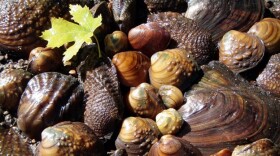We are well into summer and plants are flowering and bees are buzzing. Sure, the orchids and Iris are showy and fun, but how about showing some love for those less-appreciated, and let’s just say it, unwanted plants? As we move through the season, keep your eye out for these unloved plants. They are all native to Wisconsin and belong here just as the maples and hazelnuts and lady slippers belong in our woods.
Stinging nettle, or Dioica urtica is reported from every Wisconsin county except one. It is probably there, too, but maybe the local botanists decided to pass on collecting it. Even the Latin name, Urtica, sounds like it is going to hurt. When touched, the hairs that cover these plants break off and turn into little hypodermic needles that inject nasty chemicals into your skin, causing a painful sting. On the other hand, nettles are the main host for the Red Admiral, a handsome butterfly found in many parts of the world. Nettles are evidently quite tasty, and the stinging chemicals are detoxified as they are boiled. They are even used as a source of fiber, much like flax. Despite these slightly positive qualities, nettles, found worldwide, are universally disliked.
Another unloved plant of the Northwoods is Poison Ivy or Toxicodendron radicans. While it may be hard to believe, poison ivy is in the same plant family, the Anacardiaceae, as some of our favorite foods, mangoes and cashews. You have probably heard the saying “leaves of three, let it be”, and though poison ivy isn’t the only plant with three leaves, it is good rule. All parts of the plant contain urushiol oil that causes a miserable, itchy rash and blisters if exposed to skin. Not all people are sensitive to its sap but if you do get blisters, the pus in your blisters is produced by your own body and will not spread the rash. When I was a kid, we always celebrated the last day of school by playing flashlight tag, a game of hide and seek played in the dark. One year I found the best hiding place EVER. It was only the next day, after I broke out in an agonizingly itchy rash that I discovered my hiding spot was a bed of poison ivy.
In the Northwoods, poison ivy is usually a small plant no more than a few inches tall, but in southern Wisconsin and other parts of the US, it often grows as a woody vine, climbing high into the trees. If you want to clear out poison ivy in your yard, be sure to wear long sleeves and gloves, and consider throwing out the lot – the poison ivy and your clothes - in the trash. Whatever you do, do not burn poison ivy – if the smoke gets into your lungs you will likely land in the hospital. Despite its nasty effects on delicate human skin, plenty of birds and animals rely on poison ivy throughout the year. More than 100 insects and mites visit poison ivy flowers for their nectar. Once pollinated, poison ivy forms little whitish berries enjoyed by wild turkeys and crows and, as unlikely as it seems, deer and bears enjoy munching on the leaves.
Another plant with a bad reputation is ragweed, Ambrosia artemisiifolia. The genus name, Ambrosia, means the fruit of the gods in classical mythology, and how it got that name is a real mystery. It is in the sunflower or aster family and is common throughout Wisconsin. Ragweed pollen is infamous as the main source of about half the cases of seasonal allergies. One plant can produce up to a million pollen grains in one day, and up to a billion in a season. But like poison ivy, the leaves are eaten by an assortment of insects and many gamebirds such as turkey and some songbirds eat the seeds.
I’ve got to admit, there isn’t a whole lot to recommend these plants, at least from the human perspective. But they still have a place in our natural ecosystems. It is a good reminder to step out of our human-centric view of nature and realize that much of the natural world may be invisible to our eyes but is nonetheless essential. So, show some love for these un-lovely plants, even if it isn’t clear how they fit into the world wide web of life.









